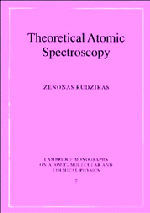Book contents
- Frontmatter
- Contents
- Preface
- Foreword to the Paperback Edition
- Introduction
- Part 1 Energy Spectrum of Many-electron Atom. Radiative and Autoionizing Transitions (Initial Formulas)
- 1 Non-relativistic atomic Hamiltonian and relativistic corrections
- 2 Relativistic atomic Hamiltonian. New wave function
- 3 Perturbation theory for the energy of an atom
- 4 Radiative and autoionizing electronic transitions. Generalized expressions for electric multipole (Ek) transition operators
- Part 2 Foundations of the Angular Momentum Theory. Graphical Methods
- Part 3 Description of Complex Electronic Configurations
- Part 4 Second-quantization in the Theory of an Atom. Quasispin and Isospin
- Part 5 Matrix Elements of the Energy Operator
- Part 6 Electric and Magnetic Multipole Transitions
- Part 7 Calculation of Energy Spectra and Electronic Transitions in the Case of Complex Configurations
- Epilogue
- References
- Index
4 - Radiative and autoionizing electronic transitions. Generalized expressions for electric multipole (Ek) transition operators
Published online by Cambridge University Press: 21 September 2009
- Frontmatter
- Contents
- Preface
- Foreword to the Paperback Edition
- Introduction
- Part 1 Energy Spectrum of Many-electron Atom. Radiative and Autoionizing Transitions (Initial Formulas)
- 1 Non-relativistic atomic Hamiltonian and relativistic corrections
- 2 Relativistic atomic Hamiltonian. New wave function
- 3 Perturbation theory for the energy of an atom
- 4 Radiative and autoionizing electronic transitions. Generalized expressions for electric multipole (Ek) transition operators
- Part 2 Foundations of the Angular Momentum Theory. Graphical Methods
- Part 3 Description of Complex Electronic Configurations
- Part 4 Second-quantization in the Theory of an Atom. Quasispin and Isospin
- Part 5 Matrix Elements of the Energy Operator
- Part 6 Electric and Magnetic Multipole Transitions
- Part 7 Calculation of Energy Spectra and Electronic Transitions in the Case of Complex Configurations
- Epilogue
- References
- Index
Summary
Interaction of atomic electrons with electromagnetic radiation
Until now we have studied the methods of theoretical description of the energy of separate, non-interacting atoms or ions. Interaction was present indirectly while speaking about many states or excited configurations, saying nothing about the mechanisms of their creation or their lifetimes.
The wavelengths and intensities of the electronic transitions from the higher to lower (or, finally, ground) states are measured experimentally. From these data the energy levels (energy spectra) are deduced. Therefore, it is very important to have efficient and fairly general methods of theoretical description of the main quantities of electronic transitions in many-electron atoms and ions, including very highly ionized ones.
An atom in a ground state can exist for an infinitely long time, whereas any excited state exists only for a finite time interval. This time interval (lifetime of the excited state), together with the energy spectrum of the excited configuration, is one of the basic spectral characters of the quantum mechanical system considered. There exist various channels of decay of the excited states, and the realization of each of them depends on concrete physical conditions.
The finite lifetime of each excited state is the reflection of a fundamental law of nature – tendency towards minimum total energy of a system. The quantum mechanical system tends to occupy the state in which its total energy would be minimal. However, the transition of an atom to the lowest (ground) state depends on many circumstances (first of all, on the sort of excited configuration, on the presence of external fields, on the character of the matter itself – density of gas, vapours or plasma, etc.).
- Type
- Chapter
- Information
- Theoretical Atomic Spectroscopy , pp. 25 - 34Publisher: Cambridge University PressPrint publication year: 1997



